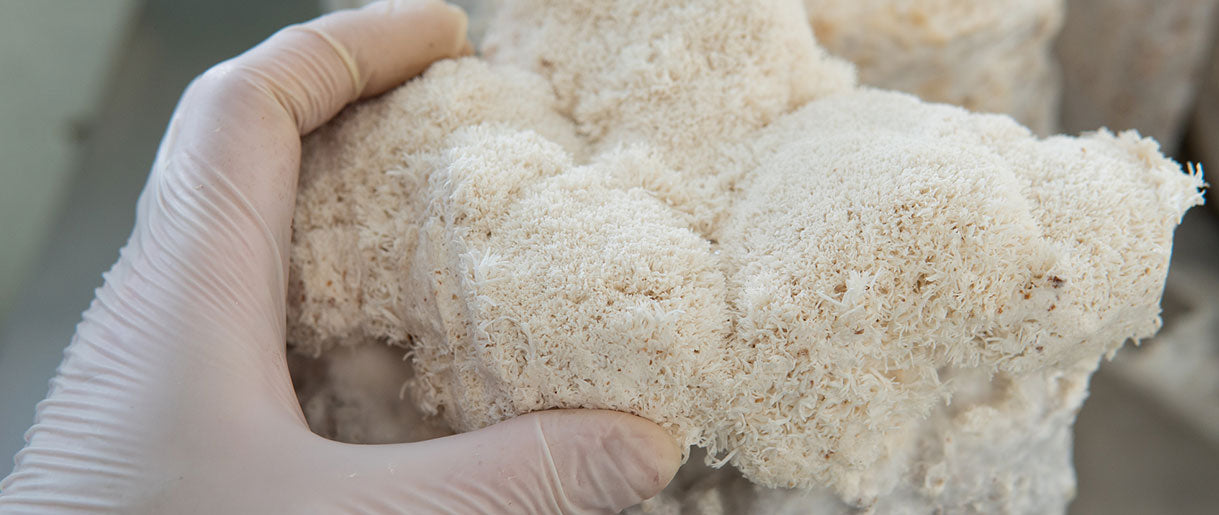Growing Lion's Mane mushrooms at home involves several key steps: preparing a suitable substrate, inoculating with spores or spawn, allowing for colonization, and triggering fruiting.
Please start by selecting a suitable substrate, such as hardwood sawdust or supplemented hardwood pellets, and hydrate and sterilize it. Next, obtain Lion's Mane spores or spawn and inoculate the substrate using aseptic techniques.
Place the inoculated substrate in a controlled environment with temperatures between 60-75°F (15-24°C) for colonization. Once fully colonized, expose the mycelium to fresh air, humidity, and indirect light to trigger fruiting. Maintain optimal fruiting conditions, and harvest the Lion's Mane mushrooms when they reach the desired size.
This detailed guide will examine everything about growing Lion's mane mushroom. Moreover, we will answer all your questions about ensuring you have a fresh Lion's mane within your reach at home.
Basics of Lion's Mane Mushroom Cultivation

Growing Lion's mane mushrooms at home can be a rewarding and exciting experience. However, before diving into the process, it's essential to understand the basics of Lion's mane mushroom cultivation. This includes creating a suitable environment and temperature, selecting the right substrate materials, and implementing proper sterilization techniques.
Suitable Environment and Temperature
Lion's mane mushrooms grow best in a controlled environment with a temperature ranging from 60-75°F (15-24°C). Growing Lion's mane indoors allows you to maintain a consistent temperature and humidity level, which is crucial for optimal growth.
Fresh Lion's mane mushrooms can be sensitive to extreme temperatures and fluctuations, so monitoring and adjusting the environment is essential. This ensures your mushroom's mycelium develops healthily and produces a bountiful harvest of younger Lion's mane mushrooms.
Interesting Read: Learn about Lion's mane look-alikes.
Substrate Materials
The substrate is the material from which Lion's mane mushrooms grow and draw nutrients. Commonly cultivated mushrooms like Lion's mane require a specific substrate to thrive.
Hardwood sawdust, supplemented hardwood pellets, or sterilized hardwood logs are ideal for growing Lion's mane mushrooms. These materials mimic the natural environment of wild Lion's mane mushrooms, providing the necessary nutrients for Lion's mane mycelium to grow and fruit.
Interesting Read: Understand the difference between Lion's mane mycelium and fruiting body.
Sterilization Techniques
Proper sterilization is vital when growing Lion's mane mushrooms, as it helps prevent contamination and promotes a healthy Lion's mane mushroom spawn. In addition, sterilizing your substrate materials before inoculation ensures that only the desired Lion's mane mycelium grows, reducing competition from other organisms.
There are several sterilization techniques, such as autoclaving, pressure cooking, or using a steam sterilizer. Regardless of the chosen method, following proper sterilization procedures is crucial to successfully grow Lion's mane mushrooms.
Step-by-Step Guide to Growing Lion's Mane Mushrooms

Preparing the Substrate
Choosing the Right Material
Growing Lions mane mushrooms begins with selecting the ideal substrate. Hardwood sawdust from hardwood trees like oak, maple, or beech, supplemented with wheat bran, is an excellent option. Alternatively, hardwood fuel pellets can also be used as a mushroom substrate.
Hydrating and Sterilizing the Substrate
Once you've chosen the suitable material, hydrate it and place it in mushroom growing or grow bags. Then, sterilize the substrate using a pressure cooker or autoclave to eliminate potential contaminants.
Inoculation
Obtaining Lion's Mane Mushroom Spores or Spawn
Purchase Lion's mane grain spawn or plug spawn dowels from a reliable supplier. Grain spawn is most commonly used for growing mushrooms, as it's easier to handle and colonizes the substrate faster.
Inoculation Techniques
Mix Lion's mane grain spawn in a sterile environment with the prepared substrate in the grow bags. Seal the grow bags and distribute the grain spawn evenly throughout the substrate.
Colonization
Incubation Period and Conditions
Place the inoculated grow bags in a dark area with a temperature between 60-75°F (15-24°C) for 2-4 weeks. This allows the Lion's mane mycelium to colonize the substrate.
Signs of Healthy Mycelium Growth
Monitor the grow bags for white, fluffy growth—a sign of healthy Lion's mane mycelium. Once the substrate is fully colonized, you can move on to the fruiting stage.
Fruiting and Harvesting
Triggering Fruiting
Cut small holes in the grow bags to initiate fruiting, allowing fresh air exchange. Place the bags in an area with indirect sunlight and maintain a humidity level of around 90%.
Maintaining Optimal Fruiting Conditions
Monitor the humidity and temperature daily, using a spray bottle to maintain moisture. Be patient, as fruiting Lions mane can take a few weeks.
Harvesting Techniques and Timing
Small fruits form on the substrate, eventually developing into full-sized mushrooms. When the edges of the Lions mane mushroom begin to curl upward, it's time to harvest. First, use a sharp knife to cut the mushroom off the substrate, not damaging the mycelium.
Troubleshooting Common Problems

Contamination and How to Prevent It
Contamination is a common issue when growing Lion's mane mushrooms, as it can hinder the growth of the desired mycelium.
Always work in a clean environment to prevent contamination and sterilize your substrate, tools, and hands before handling Lion's mane spawn. Use mushroom growing bags or grow bags with a built-in filter patch to minimize the risk of contamination during colonization.
Slow or Stalled Growth
Slow or stalled growth of Lion's mane mushrooms can be attributed to several factors, such as incorrect temperature, insufficient moisture, or inadequate fresh air exchange.
Ensure the temperature is consistently maintained between 60-75°F (15-24°C) and provide adequate humidity by misting with a spray bottle. Regularly monitor the grow bags and adjust the conditions as necessary to promote healthy mushroom growth.
Poor Fruiting or Malformed Mushrooms
If you notice poor fruiting or malformed Lion's mane mushrooms, it could be due to insufficient light, inadequate humidity, or a lack of fresh air.
To address these issues, place your grow bags in an area with indirect sunlight and maintain a humidity level of around 90%. Ensure the fresh air exchange is sufficient by cutting small holes in the grow bags, allowing for proper gas exchange.
Interesting Read: See how access to sunlight promotes vitamin D in mushrooms.
Preserving and Storing Your Lion's Mane Harvest

After you successfully grow and harvest Lion's mane mushrooms, it's essential to properly store and preserve them to extend their shelf life and maintain their health benefits. Here are some popular methods for preserving and storing your Lion's mane harvest.
Drying Techniques
Drying Lion's mane mushrooms is a popular preservation method, as it ensures a longer shelf life while maintaining the mushroom's gourmet species characteristics.
To dry your harvest, slice the mushrooms into thin pieces and place them on a drying rack or baking sheet. Keep the mushrooms away from direct sunlight, and allow them to air dry for several days until they become crisp.
Alternatively, you can use a food dehydrator to speed up the process. Once dried, store the Lion's mane mushroom in an airtight container in a cool, dark place. Then, you can use the dried fruiting bodies to make Lion's mane tea.
Freezing Methods
Freezing is another effective way to preserve Lion's mane taste and texture. To freeze your harvest, blanch the mushrooms by briefly boiling them for 2-3 minutes, then plunge them into ice-cold water to stop cooking.
Drain the mushrooms well, then spread them on a baking sheet, ensuring they are not touching. Place the baking sheet in the freezer until the mushrooms are frozen solid. Once frozen, transfer the mushrooms to an airtight container or freezer bag and store them in the freezer for up to a year.
Making Tinctures or Extracts
Creating Lion's mane tinctures or extracts is a great way to harness the health benefits of the mushroom in a concentrated form. To make a tincture, finely chop or grind the fresh fruiting body of Lion's mane mushroom and place it in a glass jar.
Cover the mushroom with high-proof alcohol, ensuring the mushrooms are fully submerged. Seal the jar tightly, and store it in a cool, dark place for 4-6 weeks, shaking it every few days. After the infusion period, strain the liquid through a cheesecloth or fine-mesh strainer, and transfer the tincture to a dark glass bottle for storage.
Incorporating Lion's Mane Mushrooms Into Your Diet

Once you successfully grow Lion's mane mushrooms, it's time to enjoy their unique flavor and numerous health benefits. Here are some ideas on incorporating Lion's mane into your diet.
Cooking Tips and Techniques
Lion's mane mushrooms have a unique texture and taste, often compared to seafood, such as crab or lobster. To prepare Lion's mane, remove dirt or debris and slice it into half-inch thick pieces.
Sauté the mushrooms in butter or oil over medium heat for 3-5 minutes on each side or until golden brown and tender. The cooked Lion's mane can be used in various dishes or enjoyed with a pinch of salt and pepper.
Delicious Lion's Mane Mushroom Recipes
Numerous delicious recipes showcase the unique flavor of fresh Lion's mane mushrooms. Some popular Lion's mane mushroom recipes include:
- Lion's Mane Mushroom Pasta: Sauté the mushrooms and combine them with your favorite pasta, garlic, and a creamy white wine sauce.
- Lion's Mane Mushroom Risotto: Incorporate sautéed Lion's mane mushrooms into a creamy, savory risotto dish for a gourmet touch.
- Lion's Mane Mushroom Tacos: Use sautéed Lion's mane mushrooms as the main filling in tacos, paired with avocado, salsa, and your choice of toppings.
Experiment with different dishes and flavors to find the perfect way to enjoy this medicinal mushroom.
Incorporating Lion's Mane Supplements
For those who want to enjoy the health benefits of Lion's mane without consuming the mushrooms directly, supplements are available in various forms, such as capsules, powders, and tinctures.
These Lion's mane supplements can be easily incorporated into your daily routine, providing this unique mushroom's potential cognitive and immune-boosting benefits.
FAQs About How to Grow Lion's Mane Mushroom
How Long Does It Take To Grow Lion's Mane?
Growing Lion's mane mushrooms from start to harvest typically takes about 6 to 8 weeks. The timeline can be broken down into the following stages:
- Stage #1 (Inoculation and Colonization): After inoculating the substrate with Lion's mane spawn or spores, the mycelium takes about 2 to 4 weeks to colonize the substrate fully.
- Stage #2 (Fruiting): Once the substrate is fully colonized, it's time to initiate fruiting by adjusting the environmental conditions, such as humidity and fresh air exchange. It takes about 1 to 2 weeks for Lion's mane mushrooms to form primordia or small fruiting bodies.
- Step #3 (Harvesting): After the primordia have formed, it takes another 1 to 2 weeks for the mushrooms to grow to their full size and be ready for harvest.
Remember that the exact time it takes to grow Lions mane mushroom can vary depending on factors such as the growing conditions, the quality of Lion's mane grain spawn or spores, and the substrate used. For these reasons, Lion's mane grow time may vary for different people.
Can I Grow Lion's Mane At Home?
Yes, you can grow Lions mane mushrooms at home. To do so, you will need the appropriate materials, such as a suitable substrate, Lion's mane spawn or spores, and an environment with the right temperature and humidity levels.
The process involves preparing and inoculating the substrate with the spawn or spores, allowing the mycelium to colonize the substrate, and then adjusting the environmental conditions to trigger fruiting. This detailed guide shows you how to grow Lion's mane from scratch.
Growing these delicious mushrooms at home is a rewarding experience that allows you to enjoy their unique taste and numerous health benefits. While it requires time, patience, and attention to detail, the process is manageable for beginners. With the proper guidance and care, you can successfully cultivate and harvest your own Lions mane mushrooms at home.
Key Takeaways
Lion's mane mushrooms are a delicious gourmet ingredient and offer a range of potential health benefits, such as supporting cognitive function, improving digestive health, and bolstering the immune system. By growing Lion's mane mushrooms at home, you can enjoy the freshness and satisfaction of harvesting your medicinal mushrooms while reaping their numerous benefits.
You'll be well-equipped to embark on your mushroom-growing journey with the proper environment, substrate materials, and a step-by-step cultivation guide. It may take some time and patience to perfect the process, but the satisfaction of harvesting your own Lion's mane mushrooms is well worth the effort. So try it, and enjoy the fruits of your labor in various delicious dishes and health-boosting supplements.
Have you tried growing Lion's mane mushrooms at home? What's your experience so far? Please share with us in the comments section.









Let Us Know Your Comments
1 Response
Marie | November 11, 2022
We just successfully grew and harvested some lion’s mane from a bag kit we got at the farmers market. Will more grow or do we toss the contents of the bag in our compost now? I’m having trouble locating that answer online.